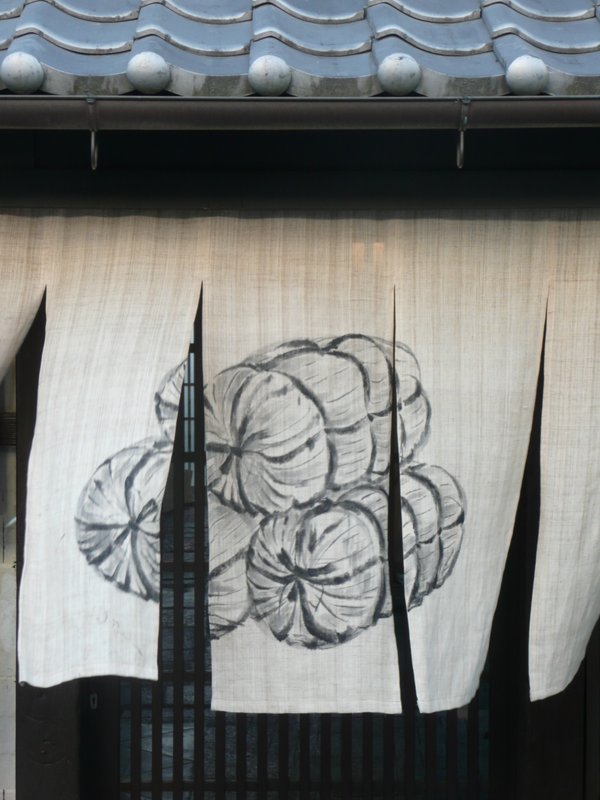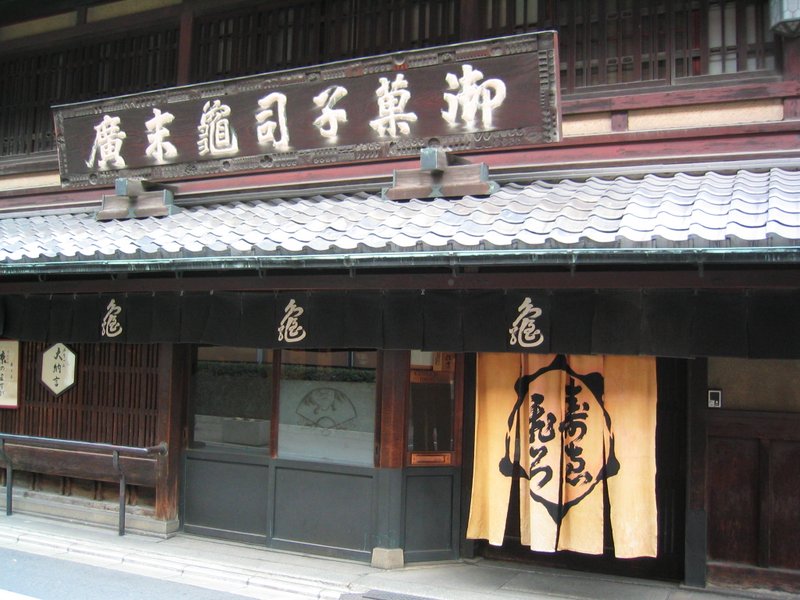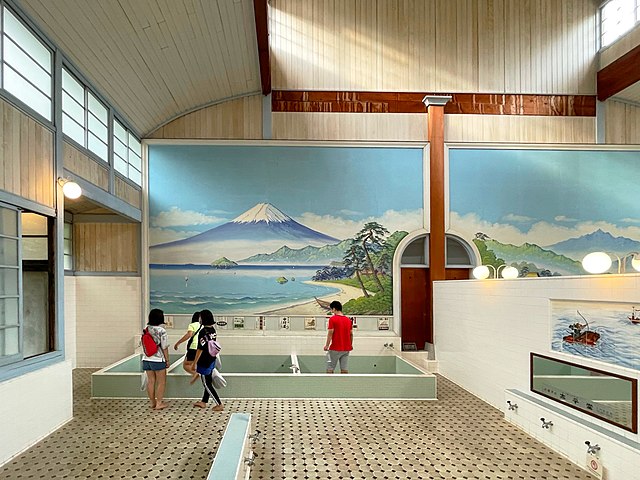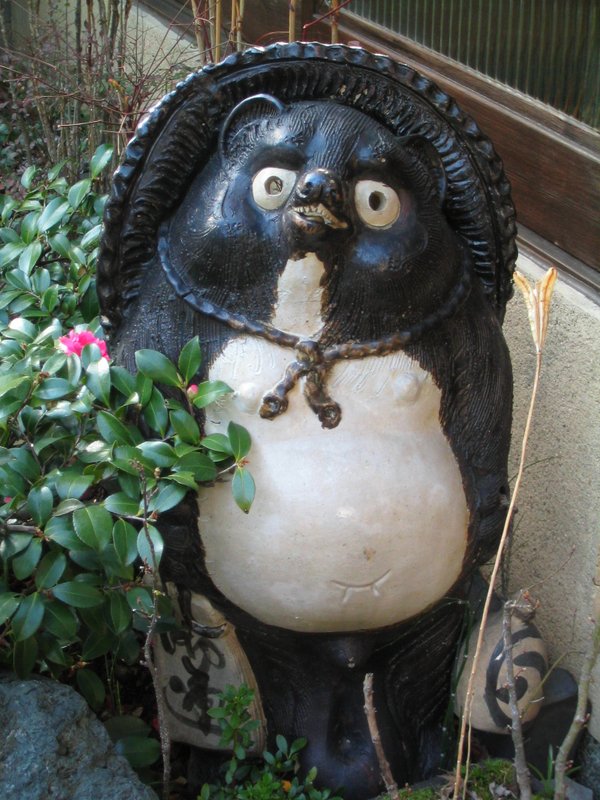More autumn topics: noren curtains, sento bathhouses, tanuki badgers

Like many cultures, autumn and spring are bookends in Japanese traditional culture and thus in daily Japanese life sort of. In fact, Japan’s younger generations remember, understand or use old traditional things less and less. But in Kyoto, the center of the center of the old worlds of Japan, many old things are still alive and well.
In this article, I have chosen three things that are special in autumn (but also special in spring and the other seasons): noren curtains (varied and exquisite crafted textiles with two sides; think entrance curtains); Kyoto communal and still going strong onsen public bathhouses; and the tanuki badger that is used, like noren, in Japan's food and drink worlds. Enjoy!
Content by Ian Martin Ropke, owner of Your Japan Private Tours (est. 1990). I have been planning, designing, and making custom Japan private tours on all five Japanese islands since the early 1990s. I work closely with Japan private tour clients and have worked for all kinds of families, companies, and individuals since 1990. Clients find me mostly via organic search, and I advertise my custom Japan private tours & travel services on www.japan-guide.com, which has the best all-Japan English content & maps in Japan! If you are going to Japan and you understand the advantages of private travel, consider my services for your next trip. And thank you for reading my content. I, Ian Martin Ropke (unique on Google Search), am also a serious nonfiction and fiction writer, a startup founder (NexussPlus.com), and a spiritual wood sculptor. Learn more!
Japan's Discreet Entranceway Noren Curtains

Noren curtains or sun shades are a wonderful Japanese handicraft made of cloth and dyed in the traditional Japanese manner. They have played an important role culturally and historically in Japan. Noren have been hanging around Japan for a long time, with a history that goes back to the Heian period (794 - 1185). Picture scrolls from the era show houses with noren used as curtains or sun shades. However, since the early Edo period (1603 - 1867) when numerous trading houses were established and dying techniques developed dramatically, shops and businesses also started hanging noren out front.
Frequently imprinted with the shop's name and/or crest, noren can be used as an indication of a shop's reputation. “The Noren has been injured (noren ni kizu ga tsuku),” means the store’s (or company’s) reputation or reliability has been damaged. In short, noren can be seen to symbolize the Japanese merchant's spirit. Therefore, customers have always considered noren as a major criterion for selecting a store.
These days, noren can be seen in use at traditional Japanese shops, restaurants, and public baths (sento), etc. As many modern establishments do not have noren at their entrances anymore, you can assume the truly Japanese ones are those that continue to use noren. In a sense, noren act, both literally and figuratively, as a form of separation between the inside and outside worlds of Japan. Noren also means tatemae, the surface attitude and feeling shown to the public for which the Japanese, especially Kyoto people, are infamous.
There are many different kinds of noren. Kimono fabric stores are often marked with long noren that almost reach the ground. Traditional drinking houses (ippai nomiya) are recognized by their nawa(twisted rice rope) noren. These days, nawa noren and ippai nomiya have become synonymous with the earthly atmosphere of the traditional Japanese bar. Sento, or a public baths, can be recognized by their colorful noren: one for the women’s side, one for the men’s.
Look for noren on your next trip to Japan. And if you can’t find one, just ask me and I will certainly locate one for you! :-)
The Japanese Public Sento Baths: Fading but stil alive!

The sento (Japanese traditional public bath) is a word with deep communal meanings in Japan. A place where people can be with people in the most natural of ways. A place to get super clean. A place to warm up in the dead of winter. A place to reconnect oneself with the old ways of the Japan and the spirit of the local community.
During the Edo era sento were perhaps the most popular community attraction as woodblock prints from that time clearly depict. In those days both women and men bathed together. It was only during the Meiji period with the arrival of strong Western influences and morals that the sexes began bathing separately. In pre-war Japan the sento was still pretty much where everyone went to wash, as baths were heated with wood, and very few people could boast of having their very own private bath. The arrival of gas lines in the 1950s changed things dramatically: suddenly people were able to have their own, easy to heat bath in the home. However, in the beginning, this was a luxury all the same, requiring considerable initial expense. But over the last twenty years nearly every Japanese home has acquired its own bathing facilities and the sentos have fallen dramatically in number. Changes in the attitudes of younger generations to traditional and inconvenient customs and practices have further eroded the customer base for sentos.
What has kept the local neighborhood sento alive and well is the fact that a fair number of homes in certain neighborhoods, often characterized by a high density of tight nagaya (row houses or townhouses) have no bath. Another factor that influences the survival and popularity of the sento is perhaps the age-old desire of people to be close to people. This is, of course, only true of those areas that still continue to foster a healthy, neighborly community spirit. And there are few. However, in cities like Osaka and Tokyo the public sento of old has all but disappeared. But larger cities and towns that survived the war and which still have extensive areas of machiya and other traditional wooden structures, there still exist a remarkable number of sentos and living community areas. Below are descriptions of 5 popular community sentos in Kyoto well worth visiting. Entry is ´ 290 (not including towel).
Don’t be surprised if people stare at you. Most patrons will assume that you’re not from the neighborhood for a number of reasons, and they’ll probably be right. Remember to behave respectfully, wash before bathing, and most importantly of all to relax and let the warmth soak into to your bones. If in doubt, do like those around you.
You can hardly go wrong.Recommended Sento in Kyoto
Funaoka Onsen: This sento is probably the oldest one in existence in Kyoto, dating from the late Edo period. The ceiling of the change rooms are high and made of fine wood. Of particular interest are a number exquisite, almost baroque ranma (Japanese wood carving panels) which partition the change room. Open daily 15:00 - 1:00. Located directly south of Daitoku-ji Temple. Tel: 441-3735.
Shomen-yu: This sento is entirely modern and thus quite the experience. Three stories high, bathers change on the first floor and then ascend, by elevator, to the second floor where there are several large baths including a big whirlpool. There is also a large sauna on the 3rd floor, more pools and the added luxury of a wooden, outdoor hot tub. Open 16:00 - 11:30 pm, closed Tuesdays. Tel: 561-3232.
Sakura-yu: This sento, located a little south of the Sanjo shopping arcade, is one of the few sentos that is open in the morning. Here you can see business people from local shops, sometimes for hours at time, relaxing, chatting and, of course bathing. This is a large sento with several big pools, a separate cold bath and shower set up, whirlpool, and steam bath (a sauna is located next door to the entrance to Sakura-yu). Located between the Teramachi and Shinkyogoku arcades three streets south of Sanjo. Open 9:00 - 23:00. Closed Fridays. Tel: 221-4062.
Tokiwa-yu: Located 50 meters southwest of the entrance to the Kurodani Temple zen complex (a wonderful place any time of day, especially around sunset when the monks file into the meditation chamber and to begin their daily 30 min. chant), Tokiwa-yu is one of several sentos remaining in the Okazaki area (where the high number of old, tiny houses, many without bath, makes the local sento indispensable). Open 16:00 - 11:30 pm, closed Wednesdays. Tel: 771-5035.
Kamogawa-yu: This sento is a fine example of a war period community sento: wooden floors, the patina of time and good use. Hot pools & cold. Steam bath too! Located 20 meters south of Kitaoji two streets east of the Kamogawa Kitaoji Bridge (east of Kitaoji Station). Open 16:00 - 11:30. Tel: 701-1739.
Japan's transformer tanuki badgers: good for business!

What is that animal standing on its hind legs, holding a bottle of sake and wearing that funny hat doing you see so often at the entrance to restaurants in Japan? Does it mean something? Yes it does! The tanuki, an ancient, popular luck charm, promises a life of prosperity, success, happiness, and health.
The hat guards against unpleasant incidents; the eyes ensure accuracy and attention; the face shows truthful communication. The sake bottle stands for the health and happiness that comes with the enjoyment of food and drink. The account ledger he carries symbolizes the importance of gaining and maintaining trust. The extended belly, or hara, is for making correct, clear, intuitive decisions. The exaggerated testicles are said to represent the ability to widen one's possibilities and capacities through financial satisfaction. And the tail is for ending things with completion.
Ceramic tanuki were first created by a Shigaraki potter, who began his pottery apprenticeship in a Kiyomizuyaki studio. One night, as he walked along the Otowa River in Kyoto, he heard a strange drumming sound. Creeping up to the sound, he found several badgers drumming on their big, rounded bellies. The potter really thought he was lucky to have seen such a thing. Soon after he moved to Shigaraki and created the ceramic badger that has become so common, and so very popular, throughout Japan today.
And the transformer aspect of tanuki is that they, like inari foxes, can acutally be a master Buddhist monk or Shinto seer transformed. So when you see a tanuki badger never forget that they can also be humans in disguise.
Return to the Japanese culture essay index.
Content by Ian Martin Ropke, owner of Your Japan Private Tours (est. 1990). I have been planning, designing, and making custom Japan private tours on all five Japanese islands since the early 1990s. I work closely with Japan private tour clients and have worked for all kinds of families, companies, and individuals since 1990. Clients find me mostly via organic search, and I advertise my custom Japan private tours & travel services on www.japan-guide.com, which has the best all-Japan English content & maps in Japan! If you are going to Japan and you understand the advantages of private travel, consider my services for your next trip. And thank you for reading my content. I, Ian Martin Ropke (unique on Google Search), am also a serious nonfiction and fiction writer, a startup founder (NexussPlus.com), and a spiritual wood sculptor. Learn more!